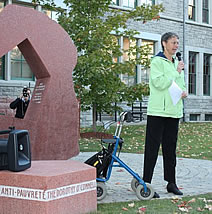Act Now

Empower U: Learn to Access Your Disability Rights Training on Canadian Human Rights, the Convention on the Rights of Persons with Disabilities (CRPD) and its Optional Protocol (OP) training aims to increase awareness of how to address discrimination using more familiar Canadian human rights laws such as Human Rights Codes and the newer international Convention on the Rights of Persons with Disabilities (CRPD). This is training for persons with disabilities by persons with disabilities. The training is part of a project funded by Employment and Social Development Canada and implemented by the Council of Canadians with Disabilities (CCD) in collaboration with Canadian Multicultural Disability Centre Inc. (CMDCI), Citizens With Disabilities – Ontario (CWDO), Manitoba League of Persons with Disabilities (MLPD) and National Educational Association of Disabled Students (NEADS). Read more.
Sign Up for our monthly digest
A monthly newsletter from CCD about what is happening in the community
What To Ask Federal Election Candidates about Disability Poverty
Related Documents
April 27, 2011
We Are Electors. We Are Women with Disabilities.
April 26, 2011
What to Ask Federal Election Candidates about Women with Disability?
April 14, 2011
Conservative Government Has Future-oriented Approach to Disability Issues
Short Term
Will your Party:
- Make the Disability Tax Credit (DTC) refundable?
- Make recipients of the Canada Pension Plan Disability Benefit automatically DTC eligible?
- Extend Employment Insurance Sickness Benefits to 52 weeks of coverage?
Long Term
Will your Party:
- Support an expanded federal role in disability income support to free provincial/territorial resources for re-investment in disability-related supports?
Inform Candidates about Disability Poverty
- The 2006 poverty rate for Canadian adults was 10.5%, 2.6 million people. For people with disabilities the poverty rate was 14.4%, 600,000 individuals.
- 55% of adults with disabilities are women and 45% are men, compared with 50.7% and 49.3%, respectively, of people without disabilities. Among people with disabilities living in poverty, 59% are women compared with 55.4% of people without disabilities living in poverty.
- Younger people with disabilities are living in poverty. Poverty rates are considerably higher for persons with disabilities up to retirement age (65 years) then fall to levels comparable to seniors without disabilities.
- Among working-age people (15 to 64 years) living in poverty 23.1% with disabilities are employed compared with 48.4% of people without disabilities and living in poverty. Some 38.4% with disabilities and living in poverty had not graduated from high school compared with 24.6% of their counterparts without disabilities. (Source: As a Matter of Fact: Poverty and Disability in Canada. For more information about poverty and people with disabilities consult additional papers developed by CCD’s CURA research project Disabling Poverty/Enabling Citizenship.)
Election 2011 Fact Sheet 1

Marie White, a former Chairperson of CCD, addresses anti-poverty rally.
